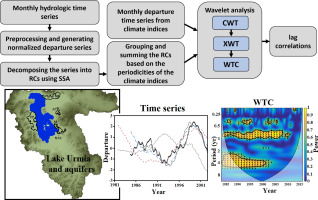当前位置:
X-MOL 学术
›
Sci. Total Environ.
›
论文详情
Our official English website, www.x-mol.net, welcomes your feedback! (Note: you will need to create a separate account there.)
Large-scale climate variability controls on climate, vegetation coverage, lake and groundwater storage in the Lake Urmia watershed using SSA and wavelet analysis.
Science of the Total Environment ( IF 9.8 ) Pub Date : 2020-03-28 , DOI: 10.1016/j.scitotenv.2020.138273 Abolfazl Rezaei 1 , Jason J Gurdak 2
Science of the Total Environment ( IF 9.8 ) Pub Date : 2020-03-28 , DOI: 10.1016/j.scitotenv.2020.138273 Abolfazl Rezaei 1 , Jason J Gurdak 2
Affiliation

|
Lake Urmia has shrunk by 88% since 1995 and is an outstanding example of an environmental tragedy in the Middle East, and the lake plays a critical role in the environment, economics, and society in the north-western part of Iran. It has been hypothesized that the drying of Lake Urmia has caused by climate variation and a climate-derived increase in droughts. Therefore, it is necessary to understand the teleconnections between the interannual to multidecadal climate variability and Lake Urmia because of the tangible implications for water resource management and policy decisions in the region. In this study, we use singular spectrum analysis (SSA), wavelet coherence analysis, and lag correlation calculations to analyze and quantify the impacts of the El Niño Southern Oscillation (ENSO), North Atlantic Oscillation (NAO), Pacific Decadal Oscillation (PDO), and Atlantic Multidecadal Oscillation (AMO) on hydro-climate variables of precipitation, temperature, lake level, groundwater fluctuations, soil moisture, vegetation coverage, and insolation clearness index in the Lake Urmia watershed. Overall, the results indicate that climate oscillations attributed to the Pacific Ocean (i.e., ENSO and PDO) have a more powerful influence than Atlantic Ocean oscillations (NAO and AMO) on the variability in the water level of Lake Urmia as well as on other hydro-climate variables, except for temperature that appears influenced by the Atlantic Ocean oscillations, particularly AMO. PDO is the first dominant mode of variability in all the hydro-climate variables (63.46% on average), except for the temperature. Overall, the wavelet coherence analysis findings indicate relatively greater PDO influence than ENSO on variability in the precipitation, soil moisture, vegetation coverage, and insolation clearness index. Furthermore, hydro-climate variables in the area have a relatively highest statistical correlation with PDO (0.69 on average, ranging from 0.54 to 0.78) compared to ENSO, NAO, and AMO. Moreover, a moderate coherence between PDO and the groundwater levels in most adjacent aquifers has occurred at the >8-year period from ~1980 to 2015. In general, the hydro-climate variables statistically have a weak lag correlation with NAO (0.19 on average, ranging from 0.13 to 0.24). AMO comprises the first mode variability in temperature (71.77%), and its coherence with temperature is moderate (~0.5) at >16-year period for the time earlier than 2000. The lag correlation between AMO and temperature (0.66) is relatively near strong. These findings have important implications for decision-makers and scientists to improve water resources planning and operations in Lake Urmia under future climate uncertainty.
中文翻译:

使用SSA和小波分析,对Urmia湖流域的气候,植被覆盖,湖泊和地下水存储进行大规模的气候变化控制。
自1995年以来,乌尔米亚湖已缩水88%,是中东环境悲剧的杰出例证,而该湖在伊朗西北部的环境,经济和社会中发挥着至关重要的作用。据推测,乌尔米亚湖的干燥是由气候变化和干旱引起的气候变化引起的。因此,由于对该地区的水资源管理和政策决策有切实的影响,因此有必要了解年际至多年代际气候变化与乌尔米亚湖之间的遥相关性。在这项研究中,我们使用奇异频谱分析(SSA),小波相干分析和滞后相关计算来分析和量化厄尔尼诺南方涛动(ENSO),北大西洋涛动(NAO)的影响,关于乌尔米亚湖流域降水,温度,湖泊水位,地下水波动,土壤湿度,植被覆盖度和日照清洁指数的水文气候变量的太平洋年代际振荡(PDO)和大西洋多年代际振荡(AMO)。总体而言,结果表明,归因于太平洋的气候振荡(即ENSO和PDO)对乌尔米亚湖以及其他水文的水位变化具有比大西洋振荡(NAO和AMO)更强大的影响。 -气候变量,但似乎受大西洋涛动特别是AMO影响的温度除外。除温度外,PDO是所有水气候变量(平均63.46%)的第一个主要变异性模式。总体,小波相干分析结果表明,PDO在降水,土壤湿度,植被覆盖度和日照清晰度指数方面的变化要比ENSO更大。此外,与ENSO,NAO和AMO相比,该地区的水文气候变量与PDO的统计相关性最高(平均为0.69,范围从0.54到0.78)。此外,在从1980年到2015年的8年间,大多数相邻含水层中的PDO和地下水位之间存在适度的连贯性。总体而言,水文气候变量与NAO的统计滞后相关性较弱(平均为0.19) ,范围从0.13到0.24)。AMO包含温度的第一模态变化(71.77%),并且在2000年之前的> 16年内,其与温度的一致性适中(〜0.5)。AMO和温度(0.66)之间的滞后相关性相对接近强。这些发现对于决策者和科学家在未来气候不确定的情况下改善乌尔米亚湖的水资源规划和运行具有重要意义。
更新日期:2020-03-28
中文翻译:

使用SSA和小波分析,对Urmia湖流域的气候,植被覆盖,湖泊和地下水存储进行大规模的气候变化控制。
自1995年以来,乌尔米亚湖已缩水88%,是中东环境悲剧的杰出例证,而该湖在伊朗西北部的环境,经济和社会中发挥着至关重要的作用。据推测,乌尔米亚湖的干燥是由气候变化和干旱引起的气候变化引起的。因此,由于对该地区的水资源管理和政策决策有切实的影响,因此有必要了解年际至多年代际气候变化与乌尔米亚湖之间的遥相关性。在这项研究中,我们使用奇异频谱分析(SSA),小波相干分析和滞后相关计算来分析和量化厄尔尼诺南方涛动(ENSO),北大西洋涛动(NAO)的影响,关于乌尔米亚湖流域降水,温度,湖泊水位,地下水波动,土壤湿度,植被覆盖度和日照清洁指数的水文气候变量的太平洋年代际振荡(PDO)和大西洋多年代际振荡(AMO)。总体而言,结果表明,归因于太平洋的气候振荡(即ENSO和PDO)对乌尔米亚湖以及其他水文的水位变化具有比大西洋振荡(NAO和AMO)更强大的影响。 -气候变量,但似乎受大西洋涛动特别是AMO影响的温度除外。除温度外,PDO是所有水气候变量(平均63.46%)的第一个主要变异性模式。总体,小波相干分析结果表明,PDO在降水,土壤湿度,植被覆盖度和日照清晰度指数方面的变化要比ENSO更大。此外,与ENSO,NAO和AMO相比,该地区的水文气候变量与PDO的统计相关性最高(平均为0.69,范围从0.54到0.78)。此外,在从1980年到2015年的8年间,大多数相邻含水层中的PDO和地下水位之间存在适度的连贯性。总体而言,水文气候变量与NAO的统计滞后相关性较弱(平均为0.19) ,范围从0.13到0.24)。AMO包含温度的第一模态变化(71.77%),并且在2000年之前的> 16年内,其与温度的一致性适中(〜0.5)。AMO和温度(0.66)之间的滞后相关性相对接近强。这些发现对于决策者和科学家在未来气候不确定的情况下改善乌尔米亚湖的水资源规划和运行具有重要意义。


























 京公网安备 11010802027423号
京公网安备 11010802027423号